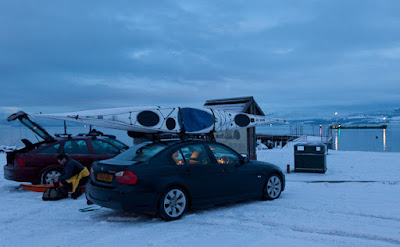The following kayak posts are about sea kayaking from Glasgow Green, in the heart of the City of Glasgow, down the tidal River Clyde to Port Glasgow at the head of the Firth of Clyde.
This morning we met at the Newark Castle car park in the upper Firth of Clyde. We then ran a shuttle on the M8 motorway into the heart of Glasgow, the "dear green place".
We were bound for Glasgow Green, the oldest of the city's many parks.
It marks the upper limit of the tidal River Clyde. Above the tidal barrage is the preserve of several rowing clubs.
Below the barrage there is a solid railing fence to discourage the locals from going for a swim, especially if they are pished.
You can drive a car and park at the West Boat House. The best entrance to Glasgow Green is off Ballater Street on the "north" bank of the Clyde. There is a "no entry approved vehicles only" sign. Assume you are approved and drive through the park at 5mph with your hazard lights on (local bye-law). On a winter Sunday, I left my car here until 17:30, well after dark, with no problem. At 09:00, when we arrived, there were about 5 rowers' cars, mine was the only one left in the evening. From talking to the rowers, they would not leave a car here after about 10pm, due to the local nocturnal wildlife.
Downstream of the barrage, there is a locked pair of yellow gates. In the past you could only paddle down the Clyde as part of a large organised group, on a specific day and an annual paddle has been held for several years now. Recently the Scottish Canoe Association has negotiated access for individual kayakers to put in below the barrage and to paddle the Cldye through Glasgow harbour to the Firth of Clyde. You can contact them for the combination for the padlock. Directly below the gate the bank is steep into deep water but 60m downstream you can launch here...
...in the corner of the Albert Bridge.
Before setting off, you should contact Clyde Estuary Control on VHF channel 12, tel: 01475726221 who will inform you of any shipping movements or whether seaplanes are expected to land/take off and warn of areas to avoid, which side of the river to follow etc..
You can download the Clydeport Marine Leisure guide from their website.
You should also contact Clyde coastguard on channel 16, tel: 01475729988 and contact them again once you are off the water. You need to carry a VHF and listen for warnings on channels 12 and 16. You also need to leave your VHF call sign with the coastguard.
Another consideration, before paddling this route, is the water level in the Clyde. In periods of heavy rain or thaw the Clyde can rise dramatically. The week before we paddled this route there was a major thaw and at Daldowie, 11km upstream of the barrage, the level was 1.4m compared with a base level of 0.2m. Down at the barrage the water was going straight over the top, creating a nasty stopper and at high tide launching would have been very dangerous down a steep bank into deep fast flowing water.
We put on when the level at Daldowie was a much more reasonable 0.4m and had little difficulty. You can monitor Clyde river levels p to 24hours previously at the Sepa website.
There is a risk of a serious bacterial infectious disease called leptospirosis or Weil's disease, which can be caused by coming in contact with fresh water contaminated by infected rats' urine. Running through a city, the Clyde has an ample share of rats so you should take precautions. Don't paddle if you have an open blister or cut. Don't let any river water get near anything you are going to eat or drink. (We normally paddle with drink bladders/tubes on deck, we didn't this time. Don't put your hands near your mouth or nose if they have been in contact with water or with grass or soil on the bank. We used alcohol gel to clean our hands before eating. You should also avoid licking your lips if water splashes on your face. We decided it would be prudent not to practice rolling in the Clyde!
The incubation period of leptospirosis is about 3 days to 3 weeks after exposure. If you develop some or all of the following: high temperature, severe headache, muscle pain, nausea, red eyes, skin rash, you should see a doctor as an emergency and say you have been paddling in the Clyde and are worried about leptospirosis.
We believe we are the first small group to make use of this new concession and it was with some anticipation that we set off below the Albert Bridge. What would we find? Some of our friends did not come fearing pollution and urban decay.










thank you Douglas your site is very informative. I plan to make use of this information soon. The clyde is a beautiful river with a very colourful history which never fails to intrigue me.
ReplyDeleteI totaly agree with you that the upper clyde is not the place to practice rolling:-D
Thanks Douglas, very informative. Looking foward to hearing what you found now!
ReplyDeleteAndy B
Thank you Alan and Andy, we found plenty!
ReplyDelete:o)